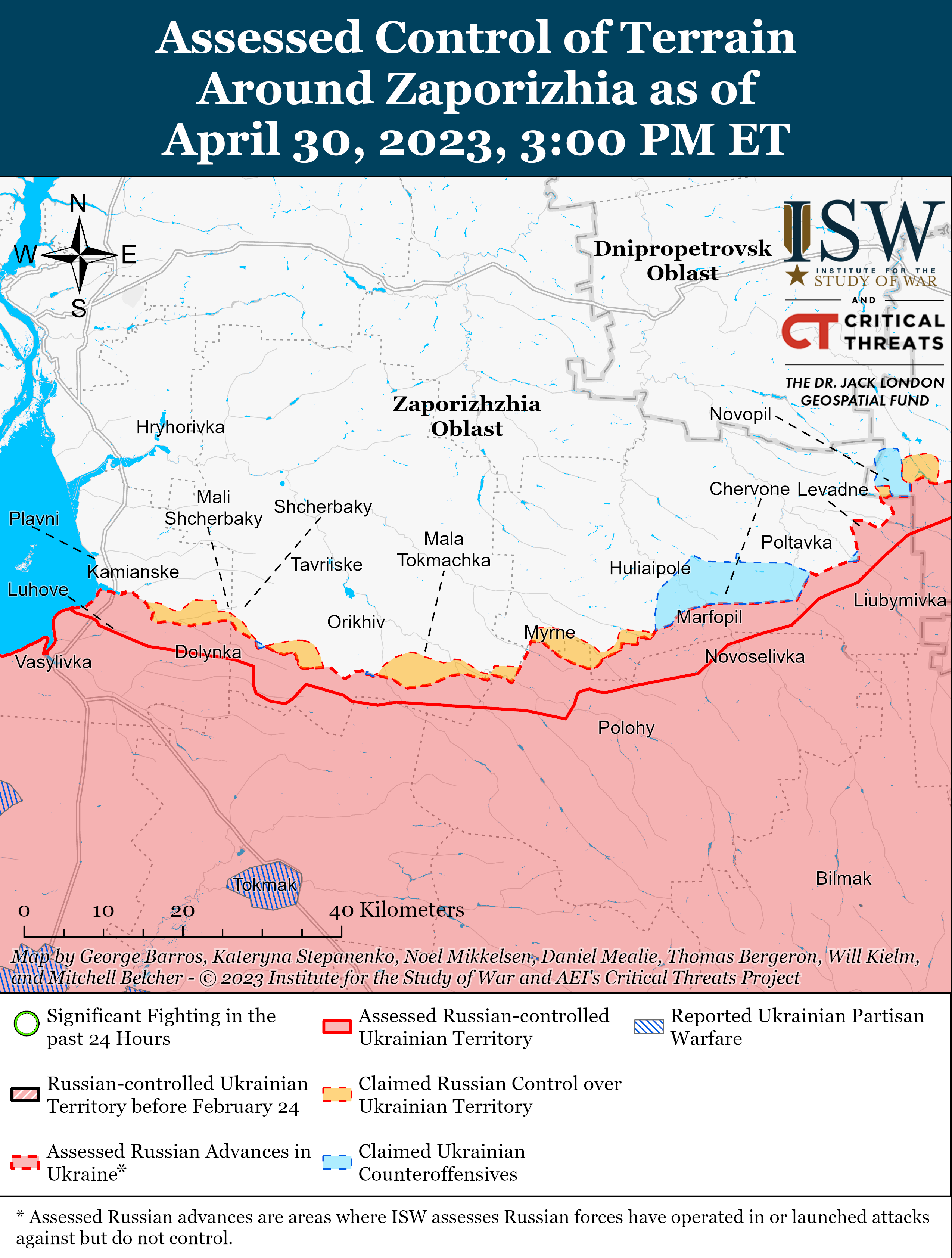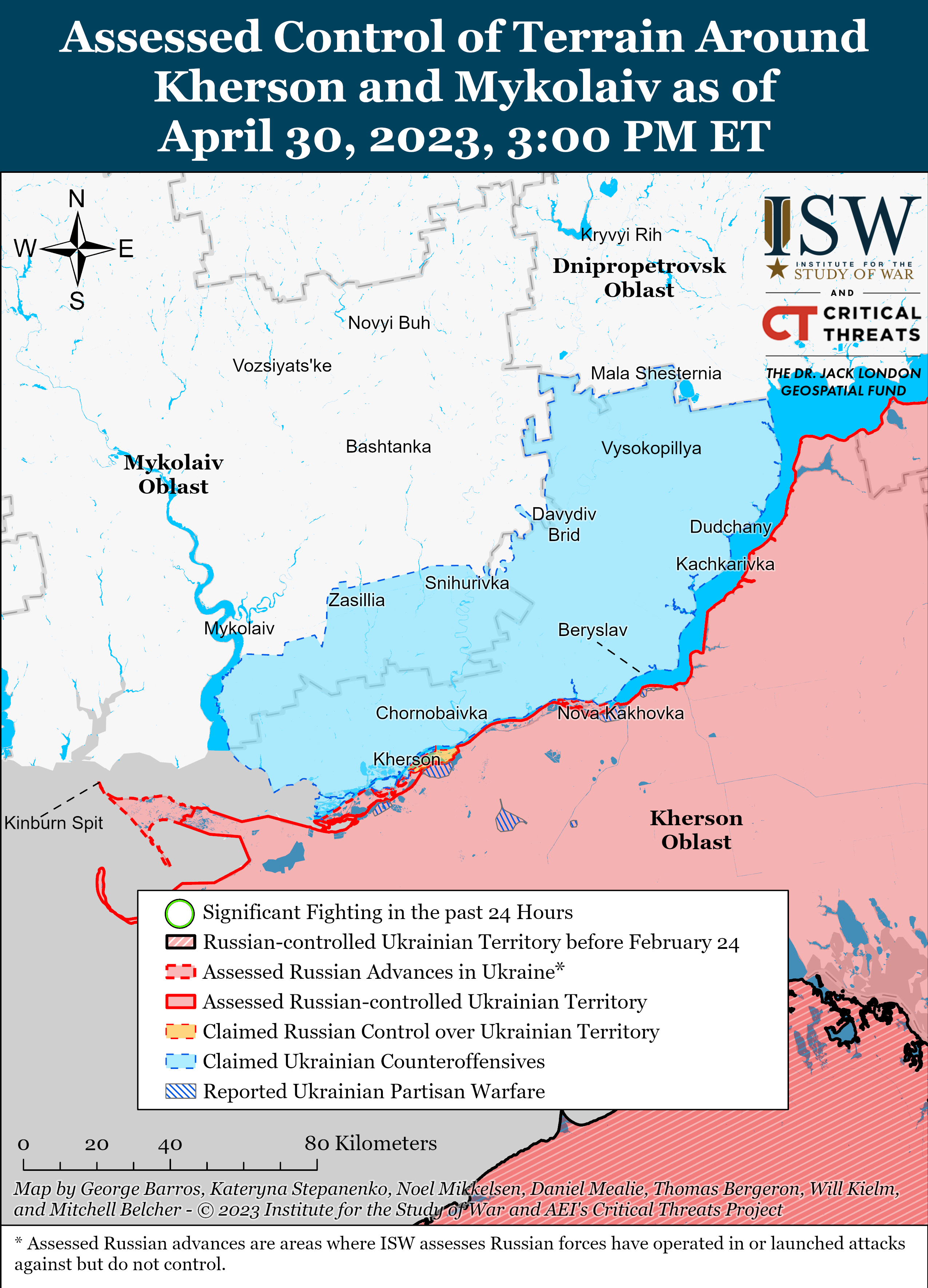 |
 |
Russian Offensive Campaign Assessment, April 30, 2023

Russian Offensive Campaign Assessment, April 30, 2023
Riley Bailey and Kateryna Stepanenko
April 30, 10 pm ET
Click here to see ISW’s interactive map of the Russian invasion of Ukraine. This map is updated daily alongside the static maps present in this report.
Click here to access ISW’s archive of interactive time-lapse maps of the Russian invasion of Ukraine. These maps complement the static control-of-terrain maps that ISW produces daily by showing a dynamic frontline. ISW will update this time-lapse map archive monthly.
ISW is publishing a special edition campaign assessment today, April 30. This report details changes in the Russian military command since Russia began its full-scale invasion of Ukraine. Russian President Vladimir Putin’s decision to invade Ukraine without a clear and doctrinal command structure and his reluctance to appoint an overall theater commander have had lasting effects on the structure of the Russian command in Ukraine. Putin’s regular command changes have led to an increasingly factionalized Russian military and disorganized command structures that are degrading the Russian military’s ability to conduct a cohesive campaign in Ukraine. Factions are not a phenomenon particular to the Russian military, although their current dynamics within the Russian military are shaping decision making to an unusual degree. The Russian Ministry of Defense (MoD) and the Kremlin have been deliberately vague about most of these command changes. ISW’s timeline of the changes is based on official Russian statements as well as analysis of unconfirmed claims and reports from Russian, Ukrainian, and Western sources. The exact dates of command changes are based on the first reporting of a change and may not correspond with the formal date on which a change occurred. These command changes were likely not discrete events resulting from decisions made suddenly but were instead drawn-out bureaucratic affairs.
Russian President Vladimir Putin’s reluctance to appoint an overall theater commander for his invasion of Ukraine has had cascading effects on the Russian military including fueling intense factionalization, disorganizing command structures, and feeding unattainable expectations. Western officials reported in April 2022 that Russia had not have a single military commander of its forces in Ukraine since the start of the invasion on February 24, 2022.[1] Putin likely sought to present himself as the commander-in-chief and the mastermind of the successful invasion of Ukraine. Captured Russian military plans revealed that the Kremlin expected Russian forces to capture Kyiv in mere days, and Putin had likely wanted to declare this speedy invasion a personal geopolitical victory.[2] Putin may have been reluctant to appoint a commander for this invasion to avoid crediting a military commander with the military victory in Ukraine – a dynamic similar to the one between Soviet leader Joseph Stalin and Marshal of the Soviet Union Georgy Zhukov during World War II. Stalin had limited and outdated wartime experience and was reportedly jealous of Zhukov’s military exploits and fame. Putin has no military experience, which may have further contributed to his decision not to appoint a commander for his invasion who could have upstaged him by claiming credit for the expected dramatic victory.
Putin appointed the first overall theater commander, Army General Alexander Dvornikov, in April 2022 in response to Russia’s failed attempt to drive on Kyiv but had replaced him by the end of May due to Dvornikov’s inability to achieve Putin’s high expectations in the first months following the retreat from Kyiv. Putin appointed Dvornikov immediately after Ukraine’s counteroffensive around Kyiv as he likely became aware that the war in Ukraine would become a longer operation requiring a more defined command structure.[3] Dvornikov was the Southern Military District (SMD) commander at the time and throughout his tenure as overall commander. Putin reportedly instructed Dvornikov to capture Donbas by the Victory Day holiday on May 9, setting Dvornikov up for failure (although neither Putin nor Dvornikov may have realized that fact at the time).[4] Putin also tasked Dvornikov with establishing a single uniform command for Russian operations in Ukraine.[5] Dvornikov failed to achieve either goal and Putin subsequently appointed Army General Gennady Zhidko in Dvornikov’s place by the end of May.[6] Putin also appointed Zhidko to replace Eastern Military District (EMD) commander Colonel General Alexander Chaiko, likely in order to continue having the theater commander hold a dual position as one of the military district commanders.[7] The dual roles given Zhidko and Dvornikov were likely a result of Putin’s continued reluctance to make any single general too prominent. Both Zhidko and Dvornikov became effectively first among equals rather than occupying a distinctive and unique position clearly above the other military district commanders. Putin would not appoint an overall theater commander with no other responsibilities until eight months into the war after several significant setbacks. Chaiko’s dismissal as EMD commander was also the first dismissal of a military district commander, as Dvornikov appeared to have retained command of the Southern Military District (SMD) following his demotion from overall theater commander. Chaiko’s dismissal signaled Putin’s decision to remove the commanders who had overseen the Russian military‘s failure to capture Kyiv. Putin’s reasoning for appointing Dvornikov and Zhidko specifically is unclear, although he may have chosen them because of their likely affiliations with Chief of the General Staff of the Russian Armed Forces Army General Valery Gerasimov.
The Russian military began to introduce commanders for operational directions in June and July of 2022 under the leadership of overall theater commander Colonel General Gennady Zhidko in an attempt to organize its offensive in eastern Ukraine. Zhidko likely inherited Dvornikov’s task of formalizing Russian command structures in Ukraine and sought to introduce operational groupings of forces in an effort to succeed in the task that likely contributed to Dvornikov’s dismissal.[8] Russian forces introduced Army General Sergey Surovikin as Southern Grouping of Forces commander, Lieutenant General Andrey Sychevoy as Western Grouping of Forces commander, and Central Military District (CMD) commander Colonel General Alexander Lapin as Central Grouping of forces commander before and after the Russian capture of Severodonetsk in late June.[9] The Russian military introduced the final operational direction commander following its capture of Lysychansk and subsequent operational pause in early July with Colonel General Rustam Muradov appointed commander of the Eastern Grouping of Forces.[10] While the southern and central grouping of forces were heavily involved with the attritional offensive to capture Lysychansk and Severodonetsk, it is unclear how concrete the eastern and western groupings of forces were as the command structures by the culmination of the Russian offensive following the capture of Lysychansk and Severodonetsk.[11] The Russian military command never publicly clarified the delineations between military district command and grouping of forces command resulting in public confusion and the possible degradation of the Russian military's ability to effectively conduct operations in Ukraine across multiple lines of effort, although it is unclear whether Russian commanders and forces were confused.
The attritional but partially successful offensive operations in eastern Ukraine likely gave Putin the informational backing to dismiss the remaining commanders who had failed earlier in the invasion to drive on Kyiv: Western Military District Commander (WMD) Commander Colonel General Alexander Zhuravlyov, Russian Airborne Forces (VDV) Commander Colonel General Andrey Serdyukov, and former theater commander Dvornikov from his position as SMD commander.[12] The capture of Severodonetsk and Lysychansk likely served as the catalyst for Putin to begin shifting his favor to figures not associated with Gerasimov and, by extension, the resounding failures of the first few months of the war, particularly to Lapin and Surovikin who commanded the operations that resulted in the cities’ capture.[13] The Wagner Group also emerged from the operations around Severodonetsk and Lysychansk with a budding reputation as an effective fighting force capable of making tactical gains where conventional Russian forces could not, likely further convincing Putin to begin favoring figures outside of Gerasimov’s orbit.[14]
Chechen Head Ramzan Kadyrov reported that Colonel General Sergey Kuzvovlev was operating as interim SMD commander in late July, likely indicating that the position passed to him on Dvornikov’s dismissal as First Deputy Commander of the SMD.[15] Kuzovlev‘s appointment may suggest that there were significant gaps between some dismissals and new permanent appointments, and that subordinate commanders held temporary positions during these transitional periods. These transitional periods likely disrupted Russian planning and operations.
The start of Ukrainian counteroffensives in August and September of 2022 led to widespread Russian panic, prompting more command changes while delaying the decision to dissolve the operational direction commands as entities distinct from military districts. The dismissal of Sychevoy as the Western Grouping of Forces commander several days before the start of Ukrainian counteroffensive operations suggests that the Russian military command had decided sometime in August to eliminate distinctions between grouping of forces and military district command structures.[16] Putin may have intended to further simplify the command structure for operations in Ukraine but refrained from doing so further when Ukrainian forces launched their counteroffensives in the Kharkiv and Kherson oblasts. Sychevoy likely continued as Western Grouping of Forces commander in some capacity through the start of the Ukrainian counteroffensive in Kharkiv Oblast until a series of setbacks in Sychevoy’s zone of responsibility around northeastern Kharkiv Oblast reportedly prompted the Russian military command to shift command of the grouping away from Sychevoy and his rumored replacement, Lieutenant General Roman Berdnikov, to Lapin.[17] Lapin’s appointment to oversee almost the entirety of Russian operations in Kharkiv and Luhansk oblasts likely reflected Lapin’s standing with Putin at the time. The Kremlin had increasingly made Lapin the face of the Russian offensive in eastern Ukraine throughout the summer of 2022, and Putin may have envisioned appointing Lapin as the next overall theater commander, as Lapin had long been rumored as a likely successor to Gerasimov and appeared not to be closely associated with the major MoD factions.[18] Both factions within the MoD likely welcomed or even supported Lapin’s appointment to this elevated role of responsibility, realizing that whoever was in command of this sector of the front would likely become a convenient scapegoat for Russian military failures.
The success of Ukrainian counteroffensives in Kharkiv and Kherson Oblasts led to more profound command changes and the rise of the anti-Gerasimov faction within the Russian Ministry of Defense (MoD). The unstable and confusing command and control structure involving the Eastern and Western Military districts and their corresponding groupings of forces likely compounded the chaotic Russian rout in Kharkiv Oblast and the complete collapse of Russian lines around Izyum in mid-September.[19] The subsequent Ukrainian liberation of Izyum and wide swathes of territory in Kharkiv Oblast likely prompted Putin to acquiesce to Russian Defense Minister Army General Sergei Shoigu’s and Gerasimov’s proposals to announce partial mobilization.[20] Following the start of partial mobilization Russian forces sent thousands of mobilized personnel to the front with little to no training at all in an effort to stabilize the front along the Kharkiv-Luhansk Oblast axis, which they succeeded in doing following the last decisive outcome of the Kharkiv counteroffensive with the Ukrainian liberation of Lyman on October 1.[21] The stabilization of the front allowed Putin to institute the command changes he likely had intended to make before the Ukrainian counteroffensive prevented him from doing so, and he used the uproar in the Russian information space about Russian setbacks, particularly the loss of Lyman, to justify a wide array of command changes. Putin dismissed Zhidko as both the overall theater commander and EMD commander and ended the grouping of forces command role as a separate position from the district commander in the week following the Ukrainian liberation of Lyman.[22]
The failure of two generals who were establishment MoD figures and Gerasimov affiliates likely solidified Putin’s decision to appoint a commander not affiliated with Gerasimov to the position of overall theater commander after the Kharkiv debacle. If Putin intended to appoint Lapin as overall theater commander the intense vitriol against him from the Russian pro-war ultranationalist community for the loss of Lyman likely dissuaded Putin from giving Lapin a larger role in the Russian campaign in Ukraine at the time.[23] The Kremlin was also increasingly relying on and amplifying the standing of ultranationalist figures with their own paramilitary structures in Ukraine: Kadyrov and Wagner financier Yevgeny Prigozhin.[24] Putin likely sought to secure the support of the pro-war ultranationalist community when he appointed their preferred candidate, Surovikin, to the position of overall theater commander.[25] Putin likely viewed Surovikin as the last untarnished high-ranking commander in Ukraine he could appoint to overall theater command. Surovikin became the first publicly acknowledged overall theater commander, one of the most central aspects of the Kremlin’s and the MoD’s campaign to publicly address criticisms of the Russian military’s setbacks in Ukraine.[26] Putin also likely publicly appointed Surovikin to insulate the Kremlin and the Russian military establishment from further criticism for any future operational failures associated with the ongoing Ukrainian counteroffensive in Kherson Oblast.
The Kremlin likely did not intend to replace Lapin as CMD commander in late October 2022. Lapin reportedly resigned because he did not want to be the public face of the failures associated with the Kharkiv counteroffensive and due to his anger at Gerasimov and the MoD for not defending him from public criticism as they had done for commanders earlier in the war.[27] Lapin’s reported resignation led to a temporary replacement by the head of the CMD’s organizational and mobilization department Major General Alexander Linkov, a particularly strange candidate for a command position given that most military district commanders previously held deputy command positions or high-ranking positions on the General Staff, further suggesting that the Kremlin did not intend to replace Lapin.[28] Both the CMD and WMD command structures would continue to be unclear or unpublicized for the following months, possibly indicating how thoroughly Ukrainian forces had destroyed their elements in the Kharkiv counteroffensive and their likely subsequent lack of combat effectiveness in Ukraine while undergoing reconstitution and replenishment.[29]
Surovikin's tenure as overall theater commander increased Prigozhin’s influence and role in Ukraine as Wagner began receiving significant supplies from the Russian military and assumed responsibility for the offensive to capture Bakhmut.[30] The Russian information space either tolerated or celebrated Surovikin’s conduct of the withdrawal from the west (right) bank of Kherson Oblast and initially lauded Surovikin for overseeing the start of Russia’s air campaign against Ukraine’s critical infrastructure.[31] The expanding influence of Surovikin and Prigozhin unnerved many within the Kremlin and the MoD, however, especially as Prigozhin became more publicly vocal about his opinions about the two institutions.[32] Possible counterweights to Prigozhin from within the MoD establishment such as EMD commander Rustam Muradov or WMD commander Sergey Kuzovlev commanded a fraction of Surovikin's and Prigozhin’s influence, and the Kremlin and the MoD likely began considering the possibility of having a notable figure from the Gerasimov faction return to assume a larger role in Ukraine.
Gerasimov and his affiliates likely attempted to convince Putin that they could successfully conduct Russia’s upcoming winter-spring offensive as the Ukrainian fall counteroffensive culminated from December 2022 to early January 2023. An unconfirmed Russian source claimed that Gerasimov attempted to persuade Putin to reinstall the “old guard” - namely Lapin, Dvornikov, Zhuravlev, Serdyukov, and Chaiko – during his meeting with Putin in Rostov-on-Don on December 18.[33] While ISW cannot verify this statement, Gerasimov began to appear in several high-profile meetings with Putin, Shoigu, and the Russian military command in late December, where he likely attempted to shift Putin’s favor to his camp.[34] Gerasimov’s camp also likely launched an information campaign to discredit Wagner mercenaries with the aim of portraying Wagner-affiliated generals as reckless. ISW observed an increase in media coverage about high casualties among Wagner prisoners, Wagner‘s careless use of ammunition, and poor Wagner discipline around December – despite the fact that Russian conventional forces had suffered from similar issues during their offensive operations earlier.[35] Unnamed Kremlin officials had previously revealed to a Russian opposition outlet that Russian security forces deliberately leak sensitive information to undermine each other.[36]
Gerasimov likely had some success convincing Putin that Wagner was wasting personnel and resources given that Wagner lost access to prisoner recruitment and access to ammunition from the Russian MoD at the start of 2023.[37] It is unclear, however, to what extent Gerasimov was able to villainize commanders such as Surovikin and VDV commander Colonel General Mikhail Teplinsky – who represent the members of the anti-Gerasimov camp. Teplinsky increasingly received the favor of Russian ultranationalist voices in the Russian information space and the VDV began cooperating with Wagner forces in the Bakhmut direction.[38] Ukrainian intelligence revealed that Wagner-linked Chief of Staff of the Eastern Military District Lieutenant General Yevgeny Nikiforov replaced Colonel General Sergey Kuzovlev as the Western Military Commander on December 26.[39] Putin also publicly awarded Surovikin on December 31, and reportedly appointed Teplinsky to command the newly formed ”Dnepr” operational grouping of forces on January 1 to defend the land corridor to Crimea.[40] Both appointments may indicate that while Putin was likely becoming more skeptical of Wagner’s ability to capture Bakhmut by at least the end of the year he still favored the anti-Gerasimov faction.
The highly attritional capture of Soledar in January likely prompted Putin to acquiesce to Gerasimov’s campaigning and appoint Gerasimov as the overall theater commander for the winter-spring offensive operation. The Russian MoD announced on January 11 that Gerasimov assumed the position of theater commander in Ukraine, demoting Surovikin to the position of deputy commander of Russian forces in Ukraine.[41] Putin likely partially caved into Gerasimov’s pressure as Wagner forces had failed to capture Bakhmut by January 1, but decisively switched sides during the Battle of Soledar, which intensified between January 4 and January 13. An unnamed source within Putin’s presidential administration stated that the long and bloody capture of Soledar triggered command changes, likely because Putin was able to confirm prior reports of Wagner’s ineffectiveness in combat.[42] Putin even attributed the victory over Soledar to the Russian MoD and the General Staff on state television, ostentatiously displaying his change of favor for Gerasimov‘s camp.[43] Gerasimov was also likely able to advocate successfully for the return of the disgraced Lapin, who assumed the position of the Chief of Staff of the Russian Ground Forces on January 10 during the final phase of the Battle of Soledar.[44] Lapin notably was not appointed to command forces on the frontlines, which may indicate a strain within the Lapin-Gerasimov relationship – possibly as a result of Gerasimov’s inability to shield Lapin from criticism. Prigozhin claimed that Lapin’s biggest mistake was that he blindly followed orders, which if true, could be a ground for conflict when Gerasimov did not repay Lapin with the same loyalty.[45]
Gerasimov spearheaded a ruthless campaign to eliminate irregular armed formations such as Wagner and its affiliates with the newfound favor he had obtained with Putin. Gerasimov began to rapidly integrate the Donetsk and Luhansk People’s Republics’ (DNR and LNR) into the Russian Armed Forces, dismiss proxy commanders, and introduce professionalization measures that upset many ultranationalists and proxy fighters.[46] Gerasimov may have attempted to punish Teplinsky for his affiliation with Wagner by committing VDV forces to a grinding battle for Soledar, although he may simply have been using the only high-quality uncommitted reserves available to him. Unconfirmed Russian sources claimed that Teplinsky resigned or took a leave of absence on January 12 after a personal conflict with Gerasimov about the use of VDV forces in human wave attacks – likely around Soledar.[47] Deputy Head of the Russian General Staff Academy Colonel General Oleg Makarevich reportedly replaced Teplinsky as the VDV commander despite having no previous VDV experience.[48] ISW previously observed Russian VDV units operating in the Bakhmut-Soledar area in early January, and it is possible that Gerasimov attempted to outshine Wagner in Bakhmut with the use of VDV forces in Soledar while pinning the high losses on the anti-Gerasimov camp.[49] Gerasimov’s camp also appeared to be avenging itself on Prigozhin, Wagner forces, and the anti-Gerasimov camp by stripping Wagner’s access to prisoner recruits, reinforcements, and ammunition.[50]
Gerasimov’s camp reportedly appointed Colonel General Sergey Kuzovlev, who had been removed from his position commanding the WMD in late December, as the SMD commander around January 23.[51] Russian sources claimed that the ”opposition faction” within the Russian MoD was able to replace Linkov with Colonel General Andrey Mordvichev as the CMD commander after a previous failed attempt in October.[52] Mordvichev’s appointment may suggest that Putin either attempted to balance the factions or that some anti-Gerasimov camp members still had some influence despite Gerasimov’s command.
Russian military commanders within the anti-Gerasimov faction increasingly began to call attention to Russian military failures during the winter-spring offensive but were unsuccessful in convincing Putin to make their desired changes in February. Prigozhin began a loud information campaign attempting to persuade Putin to reappoint commanders from the anti-Gerasimov camp by consistently doubting the ability of the Russian Armed Forces to capture Donbas before spring.[53] The Gerasimov camp likely intensified restrictions on the provision of supplies to Wagner forces in Bakhmut to prevent Prigozhin from exploiting the Russian conventional forces’ defeat around Vuhledar in early February to regain favor with Putin. A Russian source claimed that Prigozhin hoped that Secretary of the General Council of United Russia Andrey Turchak would amplify his complaints about Russian military failures over the winter-spring offensive operation directly to Putin on February 16 and March 17.[54] Russian sources claimed that Turchak delivered a blunt briefing to Putin in February but was unable to convince Putin to change the military command arrangements and almost ignited a conflict with Shoigu.[55] An unconfirmed Russian source claimed that Surovikin convinced Teplinsky to delay his official resignation in late February in hopes that Turchak’s March 17 report would shift the tide in favor of the anti-Gerasimov faction.[56]
Turchak’s February 16 briefing may have alerted the Russian MoD to the anti-Gerasimov camp’s intensifying efforts to discredit the current commanders with Putin. The Russian MoD publicly confirmed four prior reported commander appointments on February 17, identifying Mordvichev as the CMD commander, Kuzovlev as the SMD commander, Nikiforov as WMD commander, and Muradov as the EMD commander.[57] The Russian MoD may have confirmed four active commanders to use as scapegoats for the failed winter-spring offensive operation in Ukraine. Putin also awarded the rank of colonel general to Nikiforov and Muradov on February 18, consistent with their positions as military district commanders, despite the fact that neither achieving any successes on the battlefield during the winter offensive.[58] Shoigu also met with Muradov on March 4 in western Donetsk Oblast, with some Russian milbloggers claiming that Shoigu ordered Muradov to capture Vuhledar in an effort to settle the widespread criticism within the Russian MoD.[59] The New York Times, citing leaked Pentagon documents, reported that Putin personally attempted to resolve the feud between Wagner and the Russian MoD by holding a meeting between Shoigu and Prigozhin on February 22.[60] The meeting likely indicates that Putin was aware of Prigozhin’s complaints about the current progress of the war but sought to avoid taking a clear side at that time.
Teplinsky set conditions for the next set of command changes by expressing his dissatisfaction with the current military command directly to Putin in late February, ultimately assuming a leading military command position in April 2023. Teplinsky published a video on February 23 congratulating VDV troops in which he called on Russian commanders to “save [their] soldiers” and not to “pay for captured villages and heights with soldiers’ lives.”[61] Teplinsky also warned commanders that “the time will come that history will hold everyone accountable” and admitted that he had not fought on the frontlines since January but wished to return to combat. Teplinsky’s video likely confirmed his frustration with the use of his forces in Soledar and reports of his insubordination with Gerasimov. Teplinsky and his allies within the VDV veteran communities reportedly directly appealed to Putin on March 15 about the MoD’s supposed poor treatment of Wagner forces, lack of transparency, and disregard for the Russian war effort.[62] Prigozhin simultaneously boasted about Surovikin and Teplinsky on March 15, likely to rally additional support for the anti-Gerasimov group.[63]
Teplinsky was successful in his efforts to discredit Gerasimov and regain command in Ukraine. Russian milbloggers claimed on March 26 that the Russian military command dismissed Muradov and speculated that Lieutenant Colonel General Sergey Kuzmenko would become EMD commander.[64] Prominent Russian milbloggers claimed that the Russian MoD recalled Teplinsky from leave on March 30 after which he deployed to the Russian Joint Grouping Headquarters in Rostov-on-Don, Krasnodar Krai to assume command of the VDV on April 1.[65] The Russian MoD also reportedly summoned Lapin alongside Teplinsky.
The widespread failures of the Russian winter-spring offensive likely prompted Putin to divide responsibility for operations in Ukraine equally between the two factions in the MoD ahead of an expected Ukrainian counteroffensive. Putin publicly identified the commanders in charge of defeating planned Ukrainian counteroffensives during his visits to occupied Luhansk and Kherson oblasts likely prior to Orthodox Easter on April 16.[66] Putin met with Teplinsky and Makarevich in Kherson Oblast, and Lapin in Luhansk Oblast. The Kremlin introduced Teplinsky as the VDV commander, Makarevich as commander of the Dnepr Group of Russian forces, and Lapin as a commander overseeing the Luhansk direction. Russian sources claimed that Putin also presented Teplinsky with an icon that had previously belonged to a Ukrainian-born Russian imperial defense minister – a symbolic nod to Teplinsky who is a Ukrainian native.[67] Kremlin Spokesperson Dmitry Peskov notably highlighted that Shoigu and Gerasimov did not travel with Putin due to “high security risks.”[68] The mention of Shoigu’s and Gerasimov’s absence (and the insulting reason given for it) was likely a signal that the Kremlin had appointed new commanders for the new phase of the war.
Lapin’s return to the frontlines indicates that Putin is attempting to maintain some balance between the two military command factions to take charge of eastern and southern Ukraine in the coming months. A Russian source claimed on April 25 that Teplinsky became the deputy theater commander overseeing “the most dangerous” Zaporizhia, Kherson, and southern Donetsk directions.[69] Teplinsky’s subordinates include Makarevich, who commands the Kherson ”Dnepr” direction, and Kuzmenko, who oversees Zaporizhia and the southern Donetsk ”East” direction.[70] Lapin reportedly assumed command of eastern Ukraine (possibly to counterbalance the influence of the anti-Gerasimov camp) and oversees: the Lyman ”Center,” the Kostyantynivka-Avdiivka-Marinka-Lysychansk ”South,” and the Kupyansk-Starobilsk ”West” directions. Mordvichev, Kuzovlev, and Nikiforov are reportedly in charge of the “Center,” ”South,” and ”West” directions, respectively. A prominent Russian milblogger also claimed that Putin officially retired Dvornikov and Zhuravlyov and dismissed Muradov on April 20.[71] Wagner began to receive ammunition and reinforcements in early April, which likely indicates that Putin had changed his mind about Wagner and Prigozhin once again.[72]

Russia’s war in Ukraine is not existential despite the Kremlin’s claims otherwise, although the war does appear to be increasingly existential for the character and composition of the Russian military. Some commanders have indicated that one of their paramount priorities is preserving the combat effective forces under their command at the expense of others.[73] This priority appears to occasionally supersede the imperative to secure gains in Ukraine and likely suggests that some commanders view the preservation of their forces as a means of retaining influence.[74] The commanders likely expect future Russian operations in Ukraine to continue to be highly attritional and may be advocating for their forces to play less attritional roles in those operations. The commanders are likely maneuvering between preserving their forces and supporting Putin’s current operational objectives, with some weighing one over the other in an attempt to maintain Putin’s favor.[75] The overall degradation of the Russian military after 14 months of fighting in Ukraine has substantially changed the overall nature of the Russian military that existed before the invasion, and the commanders likely view their own self-preservation and that of their affiliates as an existential issue that will determine who will be in charge of the Russian military in the foreseeable future.
The Kremlin and the Russian MoD have attempted to use command changes to generate desired informational effects to offset increasingly diminishing results. Putin and the MoD have either obscured or carefully announced command changes throughout the war in Ukraine to shield themselves from criticism, set up scapegoats for military failures, appease certain voices within the Russian information space, or compound efforts to sell marginal territorial gains as operational victories to the Russian public.[76] Russian commanders in general have long drawn the ire of ultranationalist figures in the Russian information space, and the Kremlin and MoD have carefully chosen moments corresponding to specific battlefield realities to justify command changes in this atmosphere of intense criticism. The Russian MoD specifically promotes commanders from the Gerasimov faction while trying to obscure the activities of those from the anti-Gerasimov faction to protect the MoD establishment and to present the image of a unified Russian military. Command changes may have temporarily appeased criticism from Russian milbloggers earlier in the war, but responses to more recent changes indicate that many Russian milbloggers now consider command changes to be a purely cosmetic response to the endemic and strategic issues that they routinely call on the Russian military to fix.[77] Some Russian authorities and milbloggers will likely continue fixating on identifying and punishing individual commanders for Russian military failures in Ukraine, however.
Putin’s affinity for rotating personnel and not outright dismissing commanders is emblematic of his style of domestic rule, a style of leadership not well suited for leading a military engaged in a costly war. Putin has long rotated personnel in government positions as a way to ensure that no one figure amasses too much political influence and to maintain support among competing factions.[78] Putin also routinely avoids outright dismissing officials and instead temporarily demotes them in order to encourage them to seek to regain his favor and to retain options for future appointments. Former EMD commander Chaiko and former VDV commander Serdyukov have appeared in Syria, and rumored former EMD commander Muradov is reportedly serving in an advisory role for the peacekeeping contingent in Nagorno-Karabakh.[79] These apparent demotions leave open the possibility that these commanders could return to Putin’s favor, as Gerasimov did at the start of 2023 and as Lapin has reportedly done recently with overseeing operations in eastern Ukraine. The regular and rotational nature of replacing officials may work in an authoritarian system only concerned with retaining the institutional power of the Kremlin, but this style of rule is detrimental to creating an effective and stable military command structure. The regularity of the command changes is disruptive to efforts to formalize command and control and the return of formerly demoted commanders (who had failed badly) is likely exacerbating the MoD’s pervasive reputational problems as well as its operational effectiveness.
The results of a potential upcoming Ukrainian counteroffensive will likely determine which faction Putin favors going forward and likely prompt further command changes in some form. The current delineation of responsibilities between commanders in Ukraine will likely establish one faction as more successful during the potential upcoming Ukrainian counteroffensive unless Ukrainian forces launch counteroffensive operations across many diverging axes. The Russian commander who faces the main direction of the potential upcoming counteroffensive will either demonstrate resounding success in defeating the counteroffensive or notable failure. That success or failure would contrast to other Russian commanders whose forces faced less intense Ukrainian counteroffensive operations, and Putin’s favor would likely shift toward the more apparently successful faction once more.
Putin is unlikely to appoint a new overall theater commander in the current circumstances, however. Putin is faced with a challenging situation in this regard, as removing Gerasimov, who is Chief of the General Staff and second only to Shoigu in the military chain of command, as overall theater commander may be too damaging to the Kremlin’s and the MoD’s reputation. Putin also likely prefers to keep the extremely loyal Gerasimov as overall theater commander, since Putin need not worry that Gerasimov would seek to undermine his authority as the leader of the Russian war in Ukraine. Putin may attempt to avoid fallout from future command changes by increasingly rewarding commanders he favors with more responsibility beyond what their official position denotes and diminishing the role of certain commanders who have fallen out of favor instead of outright replacing them.
Key inflections in ongoing military operations on April 30:
- The Ukrainian General Staff reported that Russian forces did not conduct offensive operations along the Kupyansk-Svatove-Kreminna line on April 30.[80] Ukrainian National Guard Spokesperson Rulan Muzychuk stated that Russian forces are using more artillery but conducting fewer assaults in the Kupyansk and Lyman directions than in Bakhmut and Marinka.[81]
- Russian forces conducted ground attacks in and around Bakhmut and along the Avdiivka-Donetsk City line on April 30.[82] Ukrainian Eastern Grouping of Forces Spokesperson Colonel Serhiy Cherevaty reported that Ukrainian forces continue to have access to logistics routes to Bakhmut.[83]
- A Russian source suggested on April 30 that Russian forces will likely conduct their own offensive in southern Ukraine if the potential Ukrainian counteroffensive fails.[84] The Russian source cited the fact that top Russian officials and law enforcement are discussing possible candidates to lead various districts in Zaporizhia Oblast which are currently under Ukrainian control as further evidence of Russian plans to move in the southern direction.[85]
- Ukrainian Main Military Intelligence Directorate (GUR) Head Kyrylo Budanov reported that Russia is seeking to take control of numerous Russian paramilitary groups and is trying to create a new structure that would subordinate private military companies (PMCs) to the Russian General Staff.[86]
- A Russian milblogger claimed that Russia is forming new brigades of the airborne forces (VDV), elite units that have conducted joint operations with Wagner forces in Bakhmut.[87]
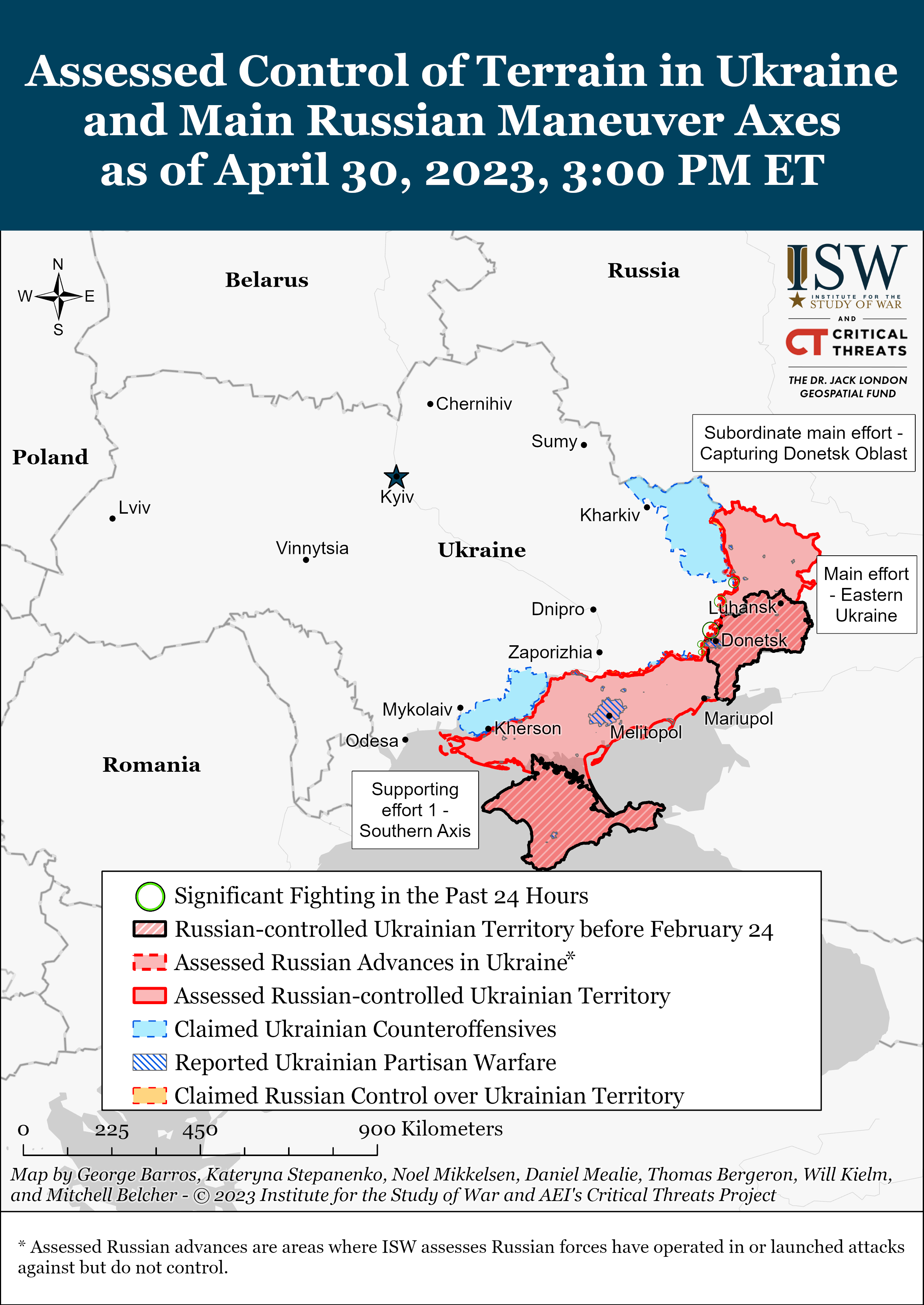
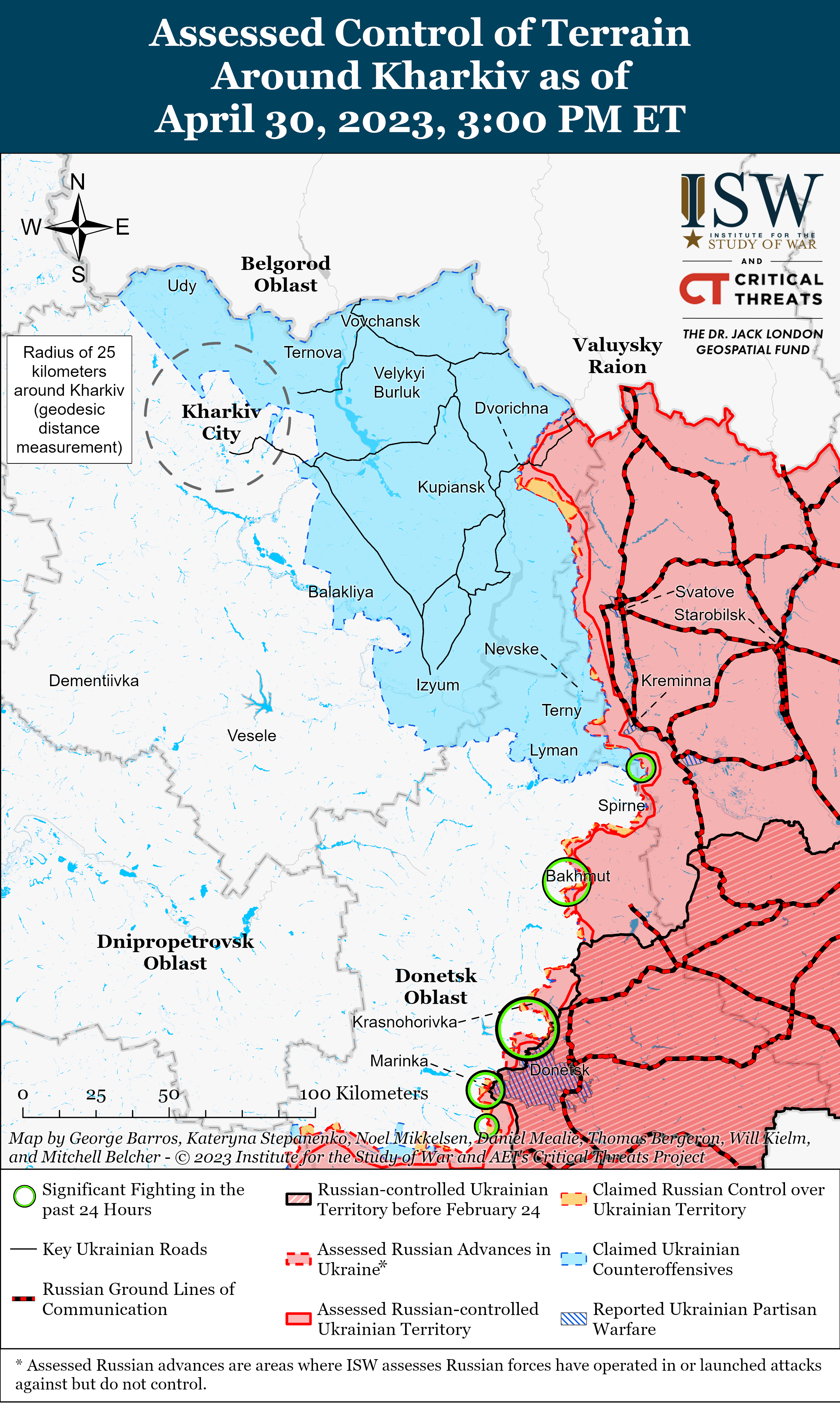
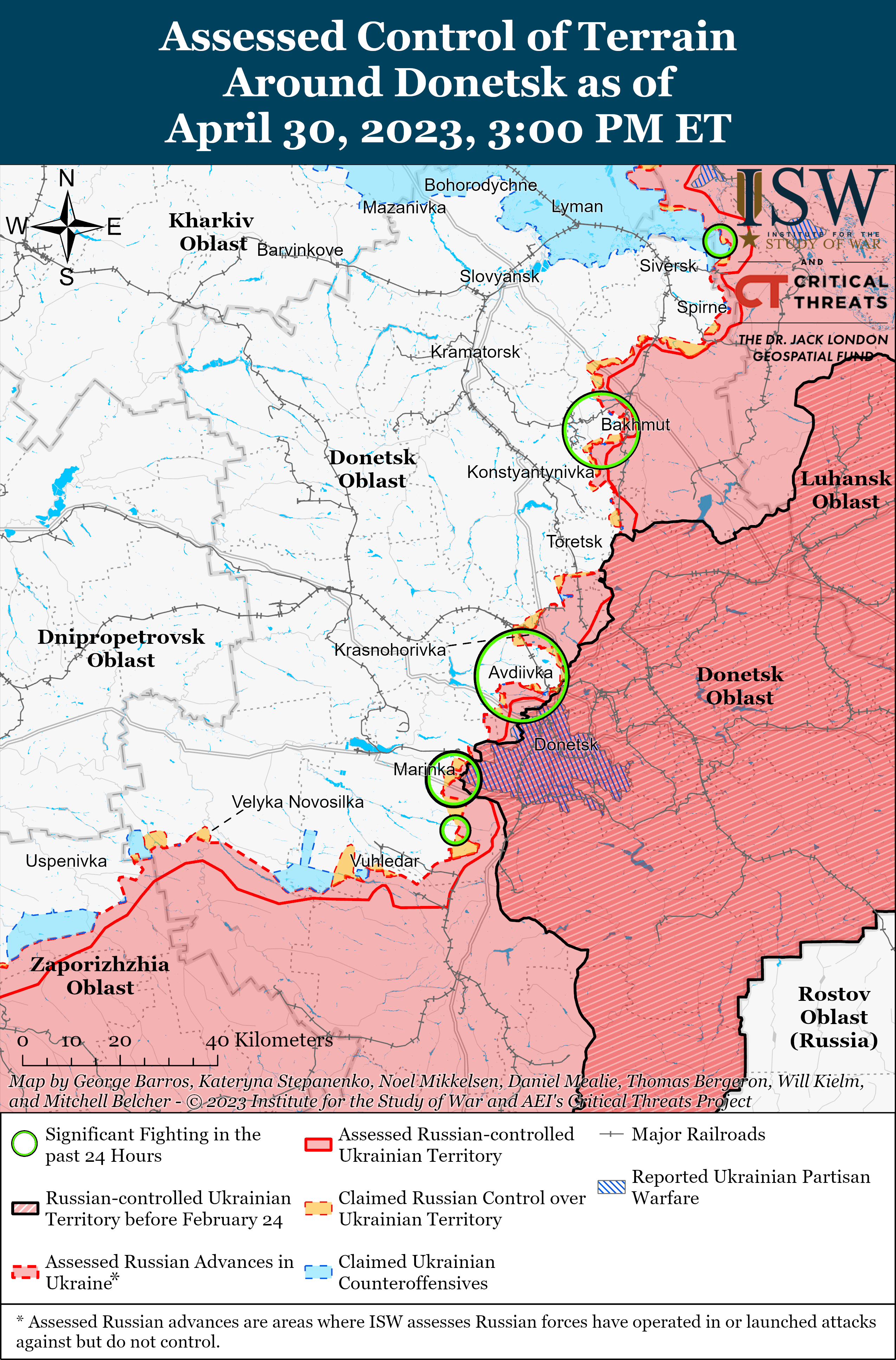
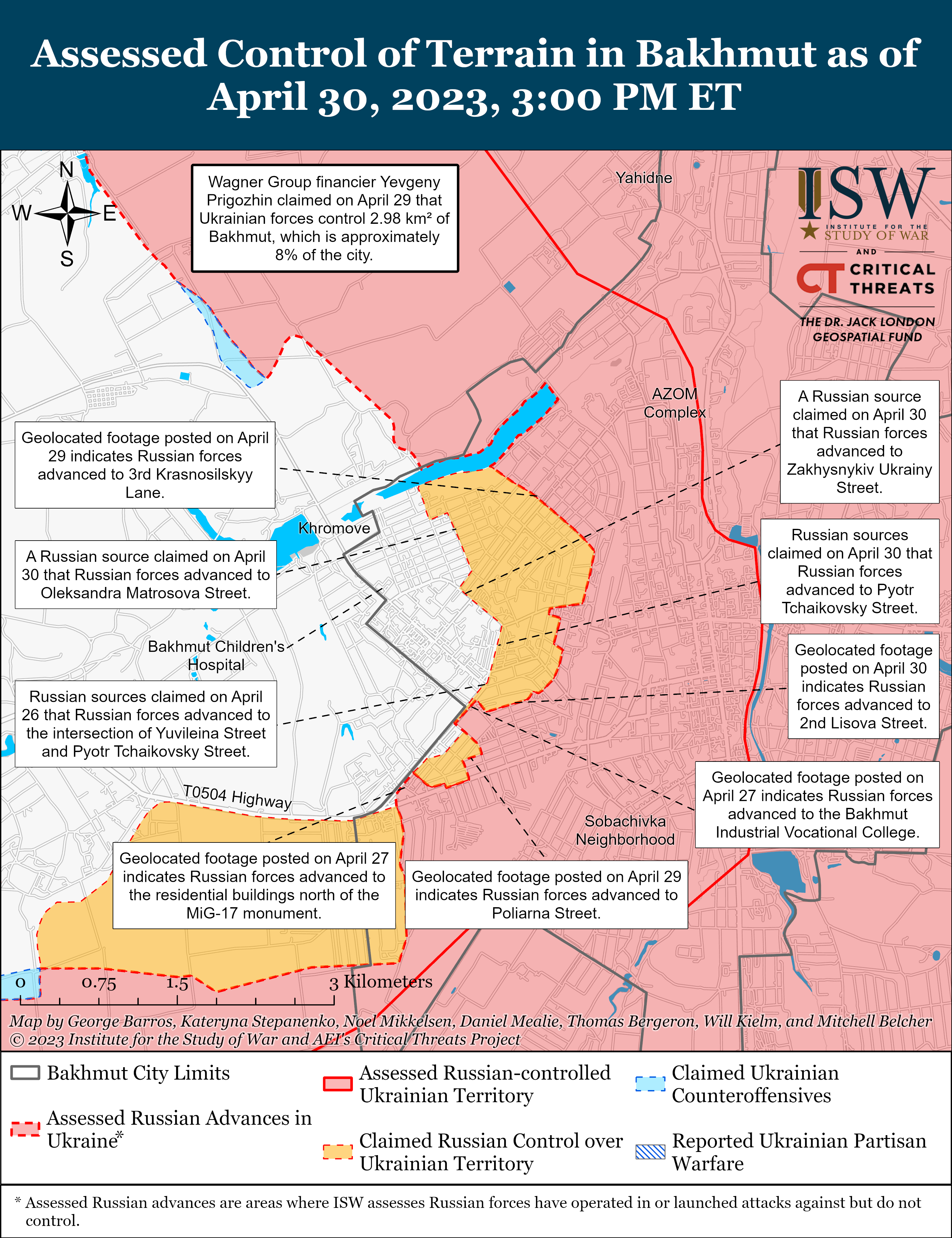
[1] https://www.washingtonpost.com/world/2022/04/10/russia-general-alexander-dvornikov-ukraine-commander/; https://thehill.com/policy/international/3263345-russia-puts-general-ale...
[3] https://hindustannewshub dot com/russia-ukraine-news/bbc-putin-replaces-military-commander-in-ukraine-the-moscow-times/; https://t.me/voenkorKotenok/34291 ; https://t.me/holmogortalks/19581 ; https://t.me/holmogortalks/19582; https://www.washingtonpost.com/world/2022/04/10/russia-general-alexander-dvornikov-ukraine-commander/; https://t.me/boris_rozhin/41229; https://apnews.com/article/russia-appoints-new-ukraine-war-commander-dvornikov-225f976f9abfb5aff6154ac3b77c21e6?utm_source=Twitter&utm_medium=AP&utm_campaign=SocialFlow
[4] https://hindustannewshub dot com/russia-ukraine-news/bbc-putin-replaces-military-commander-in-ukraine-the-moscow-times/; https://t.me/voenkorKotenok/34291 ; https://t.me/holmogortalks/19581 ; https://t.me/holmogortalks/19582; https://www.washingtonpost.com/world/2022/04/10/russia-general-alexander-dvornikov-ukraine-commander/; https://t.me/boris_rozhin/41229; https://apnews.com/article/russia-appoints-new-ukraine-war-commander-dvornikov-225f976f9abfb5aff6154ac3b77c21e6?utm_source=Twitter&utm_medium=AP&utm_campaign=SocialFlow
[6] Элита уже планирует убрать Путина? — Христо Грозев; https://twitter.com/CITeam_en/status/1529780946509209603?t=m6kn09TAhSNPZ8V6QyvNiA&s=19 ; https://t.me/m0sc0wcalling/6609 ; https://twitter.com/DefenceHQ/status/1556142982973251584
[8] https://www.understandingwar.org/backgrounder/russian-offensive-campaign... https://www.understandingwar.org/backgrounder/russian-offensive-campaign-assessment-june-21; https://www.washingtonpost.com/world/2022/10/07/russia-military-commanders-dismissed-war/ ; https://isw.pub/RusCampaignApr28
[9] https://t.me/mod_russia/17385 ; https://www.understandingwar.org/backgrounder/russian-offensive-campaign-assessment-june-28 ; https://isw.pub/RusCampaignJuly20; https://t.me/arbat/939; https://t.me/mod_russia/17792
[10] https://t.me/mod_russia/17751; https://isw.pub/RusCampaignJuly18; https://www.rbc dot ru/politics/18/07/2022/62d4f82d9a7947db28400be8;
[11] https://isw.pub/RusCampaignJuly3; https://t.me/mod_russia/17359 ; https://t.me/mod_russia/17394 ; https://understandingwar.org/backgrounder/russian-offensive-campaign-assessment-july-16; https://t.me/mod_russia/17707
[12] https://isw.pub/RusCampaignJune17 ; https://novgaz-rzn dot ru/novosti/18536.html ; https://isw.pub/RusCampaignJune21 ; https://isw.pub/RusCampaignJune25 ; https://t.me/mod_russia/17123
[13] https://isw.pub/RusCampaignJuly3; https://t.me/mod_russia/17359 ; https://t.me/mod_russia/17394 ; https://understandingwar.org/backgrounder/russian-offensive-campaign-assessment-july-16; https://t.me/mod_russia/17707
[14] https://isw.pub/RusCampaignSept14 ; https://isw.pub/RusCampaignJune21 https://www.understandingwar.org/backgrounder/russian-offensive-campaign-assessment-march-12-2023
[15] https://isw.pub/RusCampaignJuly23; ; https://t.me/RKadyrov_95/2604?single ; https://svpressa dot ru/persons/sergey-kuzovlev/
[16] https://www.facebook.com/DefenceIntelligenceofUkraine/posts/pfbid0GXZRnD7Eh1FGMN6rqoNhg74tx9beeat5Yh3qMPLWobzHFj6eZfgf8VrfbwEkikbsl ; https://t.me/arbat/1119 ; https://t.me/arbat/1144
[17] https://www.facebook.com/DefenceIntelligenceofUkraine/posts/pfbid0GXZRnD7Eh1FGMN6rqoNhg74tx9beeat5Yh3qMPLWobzHFj6eZfgf8VrfbwEkikbsl ; https://t.me/sashakots/34458; https://twitter.com/IlvesToomas/status/1567851102887989248 ; https://t.me/arbat/1119 ; https://t.me/arbat/1144
[18] https://www.understandingwar.org/backgrounder/russian-offensive-campaign... https://www.understandingwar.org/backgrounder/russian-offensive-campaign... https://www.understandingwar.org/backgrounder/russian-offensive-campaign...
[19] https://isw.pub/RusCampaignSept8 ; https://isw.pub/RusCampaignSept7 ; https://isw.pub/RusCampaignSept9 ; https://isw.pub/RusCampaignSept10
[20] https://www.understandingwar.org/backgrounder/russian-offensive-campaign-assessment-september-21
[21] https://isw.pub/RusCampaignOct1 ; https://isw.pub/RusCampaignSept23 ; https://isw.pub/UkrWar033023
[24] https://isw.pub/RusCampaignSept14 ; https://isw.pub/RusCampaignOct7 ; https://isw.pub/RusCampaignOct13; https://isw.pub/RusCampaignOct5 ; https://isw.pub/RusCampaignOct4
[30] https://www.understandingwar.org/backgrounder/russian-offensive-campaign-assessment-december-26 ; https://www.understandingwar.org/backgrounder/russian-offensive-campaign-assessment-december-24 ; https://isw.pub/UkrWar022023 ; https://isw.pub/UkrWar012223
[31] https://isw.pub/UkrWar110922 ; https://isw.pub/UkrWar102622 ; https://isw.pub/RusCampaignOct10 ; https://isw.pub/RusCampaignOct10 ; https://isw.pub/RusCampaignOct11
[34] https://www.understandingwar.org/backgrounder/russian-offensive-campaign-assessment-december-22; https://www.understandingwar.org/backgrounder/russian-offensive-campaign-assessment-december-18
[35] https://understandingwar.org/backgrounder/russian-offensive-campaign-assessment-december-22; https://www.understandingwar.org/backgrounder/russian-offensive-campaign-assessment-december-19; https://www.understandingwar.org/backgrounder/russian-offensive-campaign-assessment-november-5
[36] https://www.understandingwar.org/backgrounder/russian-offensive-campaign-assessment-april-19-2023
[37] https://www.understandingwar.org/backgrounder/russian-offensive-campaign-assessment-march-12-2023
[38] https://t.me/voenkorKotenok/41697 ; https://isw.pub/UkrWar012123 ; https://t.me/voenkorKotenok/44615 ; https://isw.pub/UkrWar122822
[40] https://twitter.com/MassDara/status/1633153547863826432 ; https://defence.org.ua/dailybrief/2023-01-01/
[42] https://verstka dot media/turbopatrioty-novaya-nesistemnaya-oppoziciya
[43] https://www.understandingwar.org/backgrounder/russian-offensive-campaign-assessment-january-13-2023
[45] https://t.me/wargonzo/12226; https://t.me/rusbrief/113137; https://dzen dot ru/video/watch/644cc90da1be2f710a8d82dc?share_to=telegram; https://t.me/concordgroup_official/863 ; https://t.me/istories_media/2431
[46] https://www.understandingwar.org/backgrounder/russian-offensive-campaign-assessment-january-20-2023; https://www.understandingwar.org/backgrounder/russian-offensive-campaign-assessment-january-18-2023; https://www.understandingwar.org/backgrounder/russian-offensive-campaign-assessment-january-23-2023; https://www.understandingwar.org/backgrounder/russian-offensive-campaign-assessment-january-17-2023; https://www.understandingwar.org/sites/default/files/Russian%20Offensive%20Campaign%20Assessment%20April%2023%202023%20%28compressed%29_0.pdf
[48] https://t.me/kremlin_sekret/9681; https://t.me/rusbrief/83673; https://t.me/arbat/1402; . https://t.me/readovkanews/50613
[49] https://www.understandingwar.org/backgrounder/russian-offensive-campaign-assessment-january-11-2023 https://www.understandingwar.org/backgrounder/russian-offensive-campaign-assessment-january-28-2023
[50] https://www.understandingwar.org/backgrounder/russian-offensive-campaign-assessment-march-12-2023
[51] https://www.rbc dot ru/politics/23/01/2023/63cec90a9a7947978567094d; https://meduza dot io/news/2023/01/23/rbk-shoygu-smenil-komanduyuschih-yuzhnogo-i-zapadnogo-voennyh-okrugov; https://t.me/boris_rozhin/76204; https://isw.pub/UkrWar012423; https://twitter.com/DefenceHQ/status/1617785717383364612?s=20&t=lJ8PecW7lpeGPIlB8v-C7g
[52] https://tass dot ru/encyclopedia/person/mordvichev-andrey-nikolaevich; https://t.me/vizioner_rf/4086
[54] https://er dot ru/activity/news/andrej-turchak-doklad-rabochej-gruppy-po-voprosam-svo-napravlen-prezidentu; https://t.me/vchkogpu/36734; https://t.me/rusbrief/93221; https://tass dot ru/politika/17300837
[57] https://www.understandingwar.org/backgrounder/russian-offensive-campaign-assessment-february-17-2023
[58] https://www.understandingwar.org/backgrounder/russian-offensive-campaign-assessment-february-18-2023
[65] https://isw.pub/UkrWar033023 ; https://t.me/rusbrief/105398; https://t.me/notes_veterans/8727 ; https://t.me/voenkorKotenok/46464 ; https://t.me/vladlentatarsky/20372; https://t.me/rusich_army/8251
[67] https://t.me/rusbrief/110012 ; https://t.me/holmogortalks/28469 ; https://t.me/holmogortalks/28467 ; https://t.me/rusbrief/109942 ; https://t.me/rusbrief/109920; https://t.me/rybar/45951
[68] https://tass dot ru/armiya-i-opk/17549851
[72] https://www.understandingwar.org/backgrounder/russian-offensive-campaign-assessment-april-17-2023
[73] https://www.youtube.com/watch?v=Lw3oEZmifK0 ; https://www.understandingwar.org/backgrounder/russian-offensive-campaign-assessment-march-12-2023 ; https://t.me/vchkogpu/37172
[74] https://www.understandingwar.org/backgrounder/russian-offensive-campaign-assessment-march-12-2023 ; https://isw.pub/UkrWar041623 ; https://www.youtube.com/watch?v=Lw3oEZmifK0 ;
[75] https://isw.pub/UkrWar042223 ; https://isw.pub/UkrWar033023 ; https://isw.pub/UkrWar03042023 ; https://www.youtube.com/watch?v=Lw3oEZmifK0
[76] https://isw.pub/UkrWar041823 ; https://isw.pub/UkrWar021723 ; https://isw.pub/RusCampaignOct7 ; https://isw.pub/RusCampaignJune25 ; https://isw.pub/RusCampaignOct8 ; https://isw.pub/RusCampaignOct11
[78] Zygar, Mikhail. All the Kremlin's Men: Inside the Court of Vladimir Putin. Public Affairs, 2017.
[79] https://t.me/milinfolive/95955 ; https://twitter.com/RALee85/status/1579541997937102848?s=20&t=fUeGwfkj-7cWK_ZWu4706Q; https://vk dot com/milinfolive?w=wall-123538639_3102045…; https://t.me/mod_russia/22045 ; https://t.me/rusbrief/112141 ; https://t.me/rybar/46271 ;
[80] https://www.facebook.com/GeneralStaff.ua/posts/pfbid057Yn7FU3RA6C9QWTsvtEaXJAdCjDmg4QsjZ53cNSqL7PpyD9Yr6SzQwYews9rHp6l
[81] https://suspilne dot media/460964-zsu-otrimaut-dalekobijni-raketi-vid-velikoi-britanii-ukraina-zalucila-persi-investicii-431-den-vijni-onlajn/
[82] https://www.facebook.com/GeneralStaff.ua/posts/pfbid057Yn7FU3RA6C9QWTsvtEaXJAdCjDmg4QsjZ53cNSqL7PpyD9Yr6SzQwYews9rHp6l; https://www.facebook.com/GeneralStaff.ua/posts/pfbid07RsrPmRw9g11Ux9RRqcxVU4aCCSuUbWduf4EuVAp6oFsG5395Q42px5JpM9EHzuzl;
[83] https://suspilne dot media/460964-zsu-otrimaut-dalekobijni-raketi-vid-velikoi-britanii-ukraina-zalucila-persi-investicii-431-den-vijni-onlajn/; https://www.youtube.com/watch?v=R5vvrb1YsqU
[86] https://gur.gov dot ua/content/kyrylo-budanov-zvilnennia-tymchasovo-okupovanykh-terytorii-pershocherhove-zavdannia-ukrainy.html




